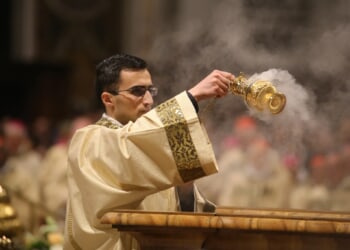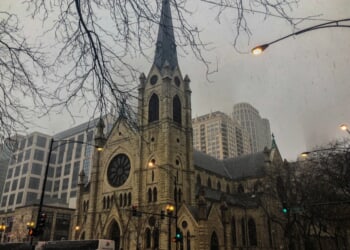Easter for faithful Christians is not about bunnies and the bloom of spring. It is about the resurrection of Jesus Christ as something infinitely greater.
How important is it? In what is likely the earliest surviving creedal profession of the core gospel (1 Cor 15:3-4), it is designated as one of the two most important “first things” in the gospel, which must be believed about Jesus and “firmly held” across the Christian life as a prerequisite for “being saved” (15:1-3): “Christ died (to make amends) for our sins in fulfillment of the Scriptures and … he has been raised on the third day in fulfillment of the Scriptures.”
Note the awkwardness of the expression, “he has been raised on the third day.” The Greek tense there is not a simple past tense (“he was raised”) but the “perfect” tense, which denotes an action that occurred in the past and whose results persist in the present. Christ was resurrected in the past, yes, but he also remains to this day in a resurrected state. He has not died since that time.
The resurrection of Christ was such a significant event for the church that it shifted the Sabbath from Saturday to Sunday. Rather than continue to have the weekly day of rest mark God’s finishing of his creation work on the last day of a week (Gen 2:1-3), the early church moved the Sabbath to “the first day of the week” (1 Cor 16:2) in order to commemorate the start of a new creation, which began with Jesus’ resurrection early on Sunday morning. God’s day was thus recalibrated as “the Lord’s Day” (Revelation 1:10).
I. Resurrection as Vindication
The resurrection of Christ is God’s confirmation and seal attesting to the truth of Christ’s claims about himself and the efficacy of Christ’s death as an offering for our sins.
It is the joy that caused the first disciples to rethink their anguish at Christ’s crucifixion. So we read in the Gospel stories about the women at the tomb (Matt 28:8-10), especially Mary of Magdala (John 20:11-18), as well as the inner circle of eleven disciples (the Twelve minus Judas; Matt 28:16-20; Luke 24:34, 36-53; Acts 1:3-9; John 20:19-23; ch. 21), especially “doubting Thomas” (John 20:24-29) and two other disciples on the road to Emmaus (Luke 24:13-35). From this joy emanated worship of Jesus (Matt 28:9, 17; Luke 24:52; John 20:28).
Paul himself reported on a list of resurrection appearances to Jesus’ followers: to “Cephas” (Aramaic for “the Rock,” Greek “Petros” or Peter), the “Twelve,” more than 500 “brothers” (believers) “at one time” (the majority of whom, Paul added, were still alive at the time of 1 Corinthians), James (Jesus’ own blood brother), “all the apostles (emissaries),” and “last of all” to Paul himself (1 Cor 15:5-8).
Through these resurrection appearances the first disciples of Jesus realized that his crucifixion was part of God’s grand plan to reclaim a fallen world for himself. God’s plan had not been thwarted. Rather, God used the evil design of human authorities to bring about the greatest possible good for the world, first through Christ’s death and now through his resurrected life. It made Jesus’ followers “witnesses” or “testifiers” (Luke 24:48; Acts 1:8, 22; 2:32; passim) to this climactic proof that Jesus indeed was “both Lord and Messiah” (Acts 2:36).
II. Enthronement to Rule
Christ’s resurrection inexorably set in motion his ascension to heaven and exaltation to sit at God’s “right hand,” as Peter declared on the day of Pentecost, fifty days after Christ’s last supper on the Passover (Acts 2:33).
This exaltation to God’s “right hand” (in the ancient Near East denoting second in command) was in fulfillment of Ps 110, the most quoted or echoed OT text in the NT. This royal psalm was originally spoken by a prophet to the Davidic king, perhaps first to David himself, at his coronation ceremony.
Here Yahweh assures the king of his help in defeating enemy nations and in extending his rule, telling him to “sit at my right hand until I make your enemies a footstool for your feet.” The new Davidic king is called on to take his seat on the throne in the royal palace, as though sitting on Yahweh’s right in the Divine Council. It is an illustration of the fact that the royal palace in Jerusalem, facing east, was situated to “the right,” or south, of Yahweh’s dwelling in the tabernacle or temple.
The early Christians thus viewed Jesus at his ascension and exaltation to heaven as fulfilling Ps 110:1 by being enthroned in the heavens “at [God’s] right hand” during his coronation as the eternal Davidic king. God the Father is now subjecting the whole of creation to Christ as king till the “last enemy,” death, is destroyed (1 Cor 15:24-28).
The early “Christ hymn” that Paul recites in Phil 2:6-11 depicts Christ’s exaltation as a reward for “emptying himself” and “humbling himself” by “becoming human” and even dying on a cross.” Though he had preexisted as one “in the form of God,” he did not count this “being equal to God” as something to be “seized” and exploited for personal gain. After his voluntary two-step self-abasement or “lowering,” Jesus was “lifted up” or “exalted” by God to a station “above” all things and given the title “Lord” (Gk. kurios), so that to Jesus “every knee should bend” and “every tongue should profess” his supreme status over all.
According to the Gospel of John, the resurrection and installation of Christ as king was the second stage of Christ’s exaltation. The “lifting up” on the cross (3:14; 8:28; 12:32-34) was the first insofar as it demonstrated Christ to be the supremely obedient Son to his heavenly Father and established him as the sole dispenser of salvation by virtue of his role as the Lamb of God who takes away the sins of the world.
III. Inauguration of the New Creation
The resurrection of Christ was even more than proof of the truth about Jesus or the means by which Christ was to be exalted over all. It was more than the mere resuscitation of a corpse, destined to die yet again. It was the start of a wholly new humanity, shaped for life in the eternal kingdom of God. Christ’s resurrection was the “first fruits” of a coming grand harvest of resurrected bodies (1 Cor 15:20, 23).
Just as Christ’s death spells the end of an old age determined by one human’s sin and spreading to all subsequent flesh, so too Christ’s resurrection marks the start of a new age determined by another human’s righteousness and spread by the pouring out of Christ’s Spirit (Rom 5:12-21).
IV. Projecting His Spirit
The resurrection of Christ is not something whose effects for his followers are delayed until he returns from heaven and bestows resurrection bodies. The resurrection has dramatic implications for all who believe in Christ in the time prior to the consummation of God’s kingdom on earth.
Peter declared in his Pentecost sermon that their new experience of the Holy Spirit was a corollary or consequence of Christ “being exalted at the right hand of God.” Jesus “received from the Father the promise of the Holy Spirit” and this Spirit Jesus has now “poured out” on those who believe in him (Acts 2:33). The Spirit of God that had uniquely indwelt Christ during his earthly ministry had now become entwined with Christ to a point where it was also the Spirit of Christ. As Paul put it, “the last Adam (Christ) became a life-giving Spirit” (1 Cor 15:45). Jesus was now able to project his presence and power, through God’s Spirit, beyond his localized resurrection body into the hearts of all those who receive him in faith.
This was the fulfillment of the words of John the Baptizer that there would be one mightier than him who would “baptize you in (with, by) the Holy Spirit” (Mark 1:8; Acts 1:4-5). In the Farewell Discourse in the Gospel of John, Jesus identified this Spirit with Jesus and the Father coming to his followers and making their “home” in them (14:23). The Spirit will be their “Advocate” or “Helper” (Gk. paraklētos, 14:16, 26; 15:26; 16:7), whose job it is to “testify on my behalf” (15:26) and “guide you into all the truth” (16:13).
As the now reigning Son of God in power, Jesus joins us to himself in “one spirit” (1 Cor 6:17). Indeed, “by one Spirit we all were baptized (immersed, plunged) into one body, whether Jews or Greeks, whether slaves or free, and we all were given one Spirit to drink” (1 Cor 12:13). This effectively transforms the aggregate of the redeemed into Christ’s new “body” on earth, the effective vehicle for his continued, and now more expansive, work throughout the world.
This gift of Christ’s Spirit in our hearts, made possible by Christ’s resurrection from the dead, is our “down payment” (2 Cor 1:22; 5:5; Eph 1:14) that one day our body, and not just our spirit, will be made completely new like Jesus’ own. In the meantime, the Spirit of Christ living within us is the controlling influence of our lives such that it can be said that we no longer live but Christ lives in us (Gal 2:19-20). In this interim between the initial infiltration of the new age into the old and the consummated renewal of all creation, we live “as if alive from the dead,” already conforming to our coming permanent identity as resurrected believers (Rom 6:12-14; 8:12-17).
The resurrected Christ is the source of our life; and the lifeline to the world above and the age to come is his Spirit extended to us. We are even now beginning to manifest a future of being dead in relation to sin but alive in relation to God’s will and purpose.
V. Inspiration
Every time I despair that the world is getting worse and my own individual life is making much too little progress, I am comforted by the knowledge (i.e., when I take the time to renew my mind (Rom 12:2; Eph 4:23; Col 3:10), that the very power of God that raised Jesus from the dead now resides in my flesh (Rom 8:11; Eph 3:16-17).
Christ lives in the heavenly realm “above,” but not just there, for he also manifests his resurrection life in me as I daily reflect with surging gratitude in my heart on how deeply he loves me and gave himself for me, expending the ultimate cost on my behalf. He lives not only beyond me but also in me, never to abandon me (Matt 28:20; Heb 13:5), ever ready to renew me as I take my eyes off of myself and gaze instead at what he has done and is doing on my behalf (2 Cor 3:18; 4:6).
Even with all that provision in this life, Paul, who suffered much for the faith, declared that “if Christ has not been raised, futile is your faith: you are still in your sins” and “we are more pitiable than all other humans” (1 Cor 15:16-19).
Jesus’ resurrection gives me hope of a transformed life that will be brought to completion in an eternity in which God is “all in all” (1 Cor 15:28). It gives me hope for a time when I can marvel at God past the veil, “face to face” (1 Cor 13:12), equipped with a body reclaimed by God and fit for a renewed heaven and earth. Oh for the day when tears and regret are supplanted by festive celebration at the great marriage feast with our Savior (Isa 25:6-9).
He lives, my friends, he lives.
READ MORE from Robert Gagnon:
Why Good Friday Is the Best of All Days
Vance Admirably Explains Christian Faith — But He Left Something Out
No, Rick Warren, Jesus Crucified Between Two ‘Bandits’ Doesn’t Mean He’s in the Middle


![NYC Tourist Helicopter Falls into Hudson River, Siemens Executive and Family Among Those Killed [WATCH]](https://www.right2024.com/wp-content/uploads/2025/04/NYC-Tourist-Helicopter-Falls-into-Hudson-River-Siemens-Executive-and-350x250.jpg)






![Green Day’s Cringe Trump Diss Ends in Fire and Evacuation [WATCH]](https://www.right2024.com/wp-content/uploads/2025/04/Green-Days-Cringe-Trump-Diss-Ends-in-Fire-and-Evacuation-350x250.jpg)
![Red Sox Fan Makes the ‘Catch of the Day’ with Unconventional ‘Glove’ [WATCH]](https://www.right2024.com/wp-content/uploads/2025/04/Red-Sox-Fan-Makes-the-‘Catch-of-the-Day-with-350x250.jpg)






